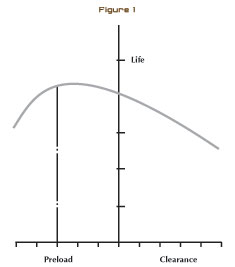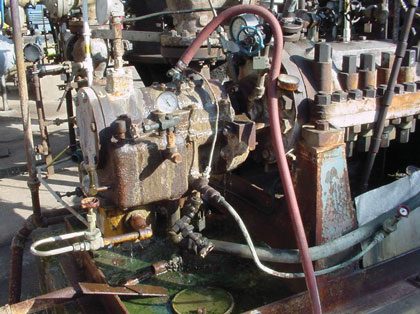As of 2014, certain pump cooling provisions can still be found in many process pumps provided by process pump manufacturers. However, the existence of such provisions does not always indicate that cooling is actually needed. This article explains cooling water-related experience at true Best-of-Class (BOC) companies. Learning from BOCs may preserve water, an increasingly valuable resource and, at the same time, reduce maintenance expenditures.
EXPERIENCE BACKGROUND WITH COOLING JACKETS
In the unlikely event that a process pump incorporates bearing housings with very small oil sumps or a combination of high speed and heavily loaded rolling element bearings, cooling the oil may be the last resort. However, and by definition, well-designed process pumps incorporate neither undersized oil sumps nor skimpy bearings. Using superior synthetic lubricants, applying the oil properly, and protecting the oil from contamination should be all that is needed for long and trouble-free bearing life.
But oil cooling is generally needed in equipment which incorporates sleeve bearings. In contrast, cooling of the oil is never needed in API-610 compliant process pumps with rolling element bearings. The experience record of many refineries with no cooling on these bearings remains highly favorable. Elimination of cooling water dates back to the 1960s when water supply valves were first closed in pumps with operating temperatures as high as 740 degrees Fahrenheit (393 degrees Celsius). Accurate measurements were made at that time and systematic dismantling of cooling water piping began.
In the late 1960s, a refinery in Southern Italy monitored bearing oil temperatures with cooling water on the bearing housing and measured 176 degrees Fahrenheit (80 degrees Celsius). Without cooling water, the bearing oil temperature dropped 18 degrees Fahrenheit (10 degrees Celsius) and leveled off at 158 degrees Fahrenheit (70 degrees Celsius). Thus, while cooling might be needed at installations with inferior pump designs, cooling the oil is of no benefit in modern pumps with rolling element bearings.

Figure 1: Bearing Life Trends. Slight preloading prevents skidding of rolling elements and actually increases bearing life (by typically 15 percent). Operating with excessive preload or with bearing-internal looseness will decrease bearing life (see reference 1).
The experience of the Italian refinery is easily explained by the behavior of steel as it heats up or cools down. It can be reasoned that a cooling water jacket restricts the bearing outer ring from freely growing in all radial directions. But as the bearing inner ring heats up and grows, bearing internal clearances are reduced and may even become negative (see figure 1). This negative clearance is known as preload. Excessive preloads will squeeze out the oil film and the bearing temperature increases. In contrast, a slight preload prevents skidding of rolling elements and actually increases bearing life by typically 15 percent. Operation with excessive preload or with bearing-internal looseness causes bearing life to decrease (see reference 1).
There is no credible record that pump bearing housing temperatures ever exceeded 190 degrees Fahrenheit (88 degrees Celsius) as long as proper viscosity synthetic oils were used. While such surface temperatures would call for personnel protection shields, neither properly selected oils nor modern rolling element bearings would be deprived of normal operating life expectancies at 190 degrees Fahrenheit (88 degrees Celsius). It is of interest that certain air-cooled bearing housings incorporate a shroud or air flow guide which, by coincidence, doubles as a personnel protector. It will be discussed later in this article.
EXPERIENCE BACKGROUND WITH COOLING COILS
First, a brief re-cap: Cooling a jacketed housing equipped with rolling element bearings is not helpful; it will not be needed. Jacket cooling prevents bearing outer races from thermally expanding, cooling will actually be harmful. Since cooling is not needed in the first place, the question of cooling coils should be moot. But what if cooling coils are used anyway? The physics of moisture condensation argue against cooling water coils in pumps that require no cooling. Immersing cooling coils in the oil will cool not only the oil but also the air in the bearing housing. Because this air is often quite moist, such cooling tends to promote moisture condensation and harmful oil contamination. Therefore, cooling water has been deleted from every pump with rolling element bearings at many Best-of-Class (BOC) locations (see references 2 through 4). That is one more reason why, since the late 1970s, modern BOC oil refineries no longer use cooling water on bearing housings with rolling element bearings.

Figure 2: 1960s vintage pump bearing housing (source: Worthington Pumps, Harrison, NJ).
However, because cooling water ports are shown on vintage pump drawings (see figure 2) a user might be led to believe that such cooling is advantageous. When it was discovered that cooling is no longer needed, BOC companies began to leave these cooling water drains open. So, irrespective of lube application method, on rolling element bearings cooling will not be needed as long as high-performance synthetic lubricants are utilized.
With sleeve bearings, cooling is used to maintain optimum oil viscosity by way of closely controlling temperature. Cooling can provide a reasonably stable viscosity environment for the oil slinger rings often used in pumps equipped with sleeve bearings. In some sleeve bearing systems oil rings (slinger rings) are used to lift the oil and deposit it on the shaft surface. In other sleeve bearings an oil spray from suitably placed nozzles is directed at oil grooves with good effect and very high reliability (see reference 5). Close oil temperature control is also needed for very large pumps; on these pumps one typically circulates the lubricating oil through water-cooled heat exchangers. Pressurization is needed to move oil through filters and water-cooled heat exchangers, but the bearing itself is rarely fully pressurized. And the “supplementary cooling method” shown in figure 3 is certainly not condoned by Best Practices Companies. ■
REFERENCES
SKF USA, Kulpsville, PA; Catalog 4000 US (1991).
Bloch, H. P.; “Machinery Reliability Improvement”, Gulf Publishing Co., Houston, TX, April 1982. Also, revised 2nd & 3rd Ed. (ISBN 0-88415-663-3).
Bloch, H.P. Pump Wisdom: Problem Solving for Operators and Specialists, (2011), John Wiley & Sons, Hoboken, NJ (ISBN 978-1-118-04123-9).
Bloch, H.P., and Budris, A.R. Pump User’s Handbook—Life Extension, (2012) 4th Ed., Fairmont Press, Lilburn, GA (lSBN 0-88173-720-8).
Bloch, H. P., and Geitner, F.K. Machinery Failure Analysis and Troubleshooting, (2012) 4th Ed. (ISBN 978-0-12-386045-3).
Bloch, H. P.; “Use Laser-Optics for Machinery Alignment”, Hydrocarbon Processing, October 1987.
Bloch, H. P.; “Laser-Optisches Maschinenausrichten”, Antriebstechnik, Volume 29, Nr. 1, June 1990.
ABOUT THE AUTHOR
Heinz P. Bloch, P.E., is one of the world’s most recognized experts in machine reliability and has served as a founding member of the board of the Texas A&M University’s International Pump Users’ Symposium. He is a Life Fellow of the ASME, in addition to having maintained his registration as a Professional Engineer in both New Jersey and Texas for several straight decades. As a consultant, Mr. Bloch is world-renowned and value-adding. He can be contacted at heinzpbloch@gmail.com.
_________________________________________________________________________
MODERN PUMPING TODAY, March 2014
Did you enjoy this article?
Subscribe to the FREE Digital Edition of Modern Pumping Today Magazine!
![]()


